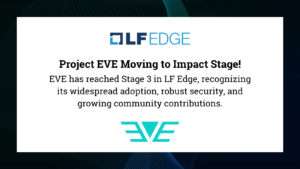Project EVE Advances to Stage 3, Demonstrating Widespread Impact and Adoption
We’re excited to announce that EVE (Edge Virtualization Engine), the open source platform for orchestrating edge computing devices and workloads, has achieved a significant milestone by moving to Stage 3, the Impact Stage, the most advanced maturity stage in LF Edge. This accomplishment underscores EVE’s growing maturity, widespread adoption, and substantial impact across various industries.
How Modernization, Analytics, and AI are Fueling the Need for Edge Computing
The need for modern edge computing solutions has exploded in recent years, driven by digital transformation initiatives across various sectors. Organizations are increasingly deploying diverse workloads, including containers and virtual machines, at the edge to enable remote analytics, predictive maintenance, and edge AI. This surge in edge computing has fueled the demand for easy-to-use, scalable, and secure remote orchestration capabilities, which EVE effectively addresses.
“EVE’s move to Stage 3 is a direct result of its widespread adaptation and deployments in production,” says Erik Nordmark, a member of the LF Edge Technical Advisory Board. “This success stems from EVE’s ability to cater to both modern and legacy workloads, facilitating smooth digital transformation: EVE empowers organizations to embrace innovation while preserving the critical functionality of their existing systems.”
EVE’s Journey to Stage 3
EVE’s progression to Stage 3 is a testament to its growth and maturity. As an open-source project, EVE has gone through a period of significant growth, attracting a vibrant community of contributors and adopters, including companies such as Speedcast, Emerson, PV Hardware, and BOBST. This growth, driven by early contributions and a clear demonstration of its potential to address key challenges in edge computing, led EVE to the Growth Stage (Stage 2). Reaching this stage required EVE to develop a well-defined growth plan, demonstrate active development through regular meetings and a substantial flow of contributions, and highlight early adoption in proof-of-concept deployments. At Stage 2, EVE continued to evolve and expand its capabilities, building momentum towards broader adoption.
EVE has now entered the Impact Stage (Stage 3), meeting the stringent criteria for this level: a robust governance structure, documented security and release processes, and demonstrated widespread production use. The move to Stage 3 acknowledges EVE’s successful track record in large-scale deployments and its capacity for continued growth.
Michael Maxey, Chair of the LF Edge Governing Board, highlights the significance of this achievement, stating, “Reaching a new stage of maturity is a significant achievement, distinct from projects that begin at a higher tier, because EVE’s progression reflects real-world adoption and impact. Within LF Edge, there are only a few that have achieved this status.”
EVE’s Strengths: Versatility and Broad Applicability
One of EVE’s key strengths is its versatility. It can be deployed on a wide range of hardware, from small ARM-based devices to large, ruggedized servers. This adaptability makes EVE suitable for diverse use cases across various industries. The project’s commitment to ongoing security enhancements further strengthens its position as a reliable and robust platform for edge deployments.
Nordmark emphasizes EVE’s broad applicability, stating, “EVE’s versatility allows it to be deployed in a remarkable range of configurations, from resource-constrained edge devices to large, high-availability clusters.”
The Future of Edge Computing with EVE
EVE’s journey to Stage 3 is a testament to the power of open-source collaboration and its ability to drive meaningful innovation at the edge. As an open-source project, EVE’s success is inextricably linked to the collaborative efforts of its vibrant community, fostering a diverse ecosystem of contributors, ideas, and use cases and widespread adoption across various industries.
“EVE’s impact extends beyond its technical capabilities, serving as an inspiration and a model for other open-source projects, such as Ocre,” says Nordmark. “By fostering a collaborative environment and embracing a diversity of perspectives, EVE has not only achieved remarkable technical milestones but has also strengthened the open-source community as a whole.”
As EVE continues to evolve, its impact on the edge computing landscape is poised to expand significantly, driving innovation, and transforming the way we interact with technology at the edge. To contribute to this exciting journey and shape the future of edge computing, developers and users are encouraged to actively participate in the project, contribute to its development, and leverage its capabilities.
To learn more about EVE and explore its potential applications, visit the LF Edge Sandbox.
